When we first started this site, we always said our patron saints were Chris Yates and Roger Deakin. If in addition there was another pontiff, then it really had to be Robert Macfarlane. Robert has been there since Caught by the River began, a constant guiding voice and influence on our forward thinking. His book, The Wild Places, came out around the time we puzzled over our first posts and seemed to cement all the ideas we’d been having; to validate all of our formative conversations. Since then, he’s contributed to the site and become a recording artist for our Rivertones record label (if you’ve not heard it, check out ‘the Sea Road’, a collaboration with the sound recordist Chris Watson).
Now, Robert has very kindly given us an exclusive chapter from his incredible new book, Landmarks, (Hamish Hamilton) our Book of the Month for March. The chapter (running today and tomorrow) takes us all back to the start – to the late great Roger Deakin. It’s an essay about the power of extraordinary place-writing to change the ways we see, feel and act. And it’s fantastic.
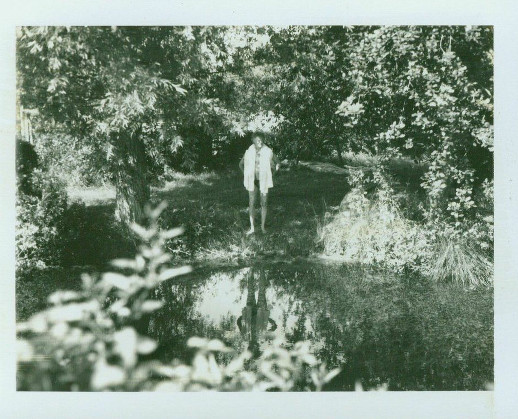 ©The literary estate of Roger Deakin
©The literary estate of Roger Deakin
Roger Deakin was a water-man. He lived for most of his life in a timber-framed Suffolk farmhouse with its own spring-fed moat, the arms of which extended around the house such that it was, in Roger’s phrase, ‘part-islanded’. The moat was connected to a cattle pond that jutted out into the largest grazing common in Suffolk, and that pond was one of twenty-four set around the common, each linked to each by an ancient labyrinth of tunnels and drains. We think of an archipelago as a scatter of land existing within water, but Roger lived on an inverse archipelago – a scatter of water existing within land. Mellis Common itself, when the wind blew in summer, appeared to him like ‘a great inland sea of rippling grasses’, so that ‘although the sea itself is twenty-five miles due east at Walberswick’, he could ‘still enjoy some of the pleasures of living beside it’.
Roger was a film-maker, environmentalist and writer who is best known for his trilogy of books about nature and adventure: Waterlog (1999), Wildwood (2007) and Notes from Walnut Tree Farm (2008). His work can be located at the convergence point of three English traditions of rural writing: that of dissent tending to civil disobedience (William Cobbett, Colin Ward), that of labour on the land (Thomas Bewick, John Stewart Collis, Clare Leighton), and that of the gentle countryman or the country gentleman, of writer as scrupulous watcher and phenologist (Gilbert White, Richard Mabey, Ronald Blythe). Roger travelled widely, but always returned to his farmhouse and the twelve acres of meadow and hedgerow that surrounded it. This was his fixed point, where one foot of his compass was planted, while the other roved and circled.
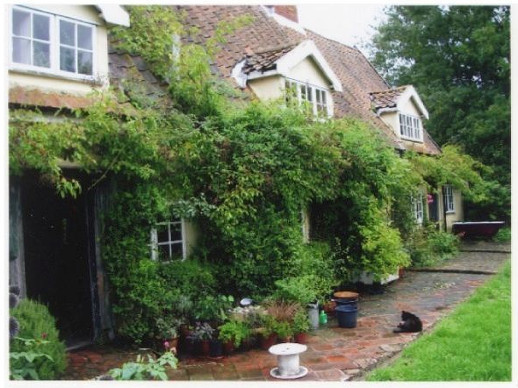 Walnut Tree Farm. ©The literary estate of Roger Deakin
Walnut Tree Farm. ©The literary estate of Roger Deakin
Walnut Tree Farm was first raised in the Elizabethan era, ruined when Roger found it in 1969, and then rebuilt by him according to an East Anglian method of timber-framing whereby the frame ‘sit[s] lightly on the sea of shifting Suffolk clay like an upturned boat’. At the back of the house was an old claw-footed iron bathtub he had salvaged from a skip or auction yard (he foraged avidly; he cherished used objects that wore their histories as patina; he disliked waste). On hot summer days, Roger would snake out twenty metres of water-filled hosepipe onto the ground near the bath, leave the pipe to lounge for hours in the sun like a lazy python, then run that solar-heated water into the outdoor bath for an al fresco wallow. The bath was his tepidarium; a cooling plunge into the moat usually followed. Out of the bath, across the grass, between the two apple trees, round the big willow to where he had staked a ladder to the moat’s bank, three steps into the water, and then gently down among the weed and the ducks and the ramshorn snails for a few lengths of breaststroke or crawl.
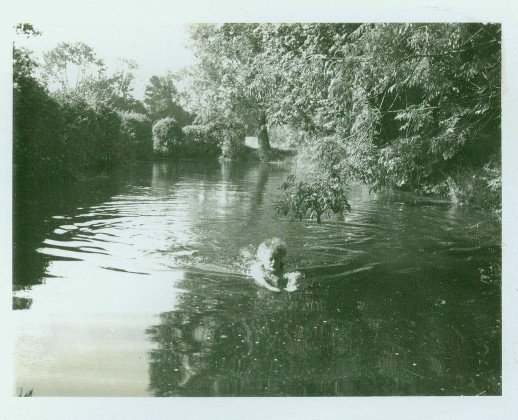 ©The literary estate of Roger Deakin
©The literary estate of Roger Deakin
‘It’s extraordinary what you see in an English moat,’ said Roger once. Water was to him a visionary substance. It was homeopathic, it was beautiful in its flex and flow – and it was a lens through which he looked. Prepositions matter again here: we might say that Roger Deakin thought not just about water, he thought in water or with water. His imagination was watery not in the sense of dilute, but in the senses of ductile, mobile, lucid, reflective. Open water offered a glass into which one peered to see local miracle and revelation (and not – for Roger was no Narcissus – oneself). ‘All water,’ he wrote in a notebook, ‘river, sea, pond, lake, holds memory and the space to think.’
It was while doing lengths in his moat during a rainstorm that the idea – the brainstorm – came to Roger for a swimmer’s journey around Britain – no, not around Britain, through Britain, via its lakes and rivers – the account of which was subsequently published as Waterlog. For a year Roger swam in some of the iconic waters of the country (Dancing Ledge on the Dorset coast; the tidal rips off the Isle of Jura; the clear-running trout streams of Hampshire), as well as less predictable places (the estuary of the Fowey in Cornwall; the mud-channels that wriggle through the East Anglian salt marshes, the tufa pools of North Yorkshire).
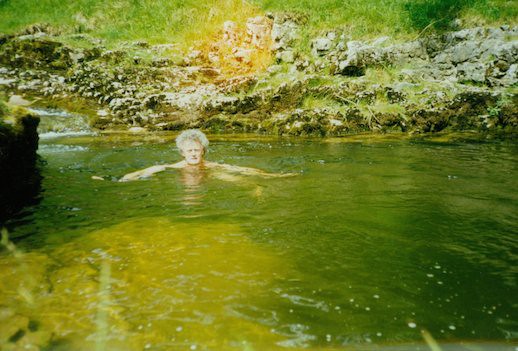 Roger in a tufa pool near Arncliffe, North Yorkshire ©The literary estate of Roger Deakin
Roger in a tufa pool near Arncliffe, North Yorkshire ©The literary estate of Roger Deakin
That journey gave Roger, and in turn its hundreds of thousands of readers, a magically de-familiarising ‘frog’s-eye view’ of the country: a world seen freshly from water level. It is a witty, lyrical, wise travelogue that sketches a people’s history of open-water swimming in Britain and offers a defence of the open water that remains, and an elegy for that which has gone (culverted, privatized, polluted).
Waterlog quickly became an exceptionally influential book. Influence is itself a watery word: the Oxford English Dictionary gives us as its first definition: ‘1. The action or fact of flowing in; inflowing, inflow, influx, said of the action of water and other fluids, and of immaterial things conceived of as flowing in.’ The affective sense of influence, the notion of being influenced by another person or property, is also aquatic in its connotations: ‘3. The inflowing, immission, or infusion (into a person or thing) of any kind of […] secret power or principle; that which thus flows in or is infused.’
I know of few other writers whose influence has been as strong as Roger’s, in the sense of ‘infusing’ itself into people, of possessing a ‘secret power’ to ‘flow’ into and change them. You finish reading Waterlog invigorated, and with a profoundly altered relationship to water. It is a book which leaves you, as Heathcote Williams nicely punned, with ‘a spring in your step’. Despite its deep Englishness, it has won admirers internationally, and been translated into languages as various as Italian, Korean and Japanese. In the two years after its first publication, Roger would typically receive three or four letters or telephone calls each day from readers seeking to make contact and tell him their own swimming stories or share their swimming spots. The book prompted a revival of the lido culture in Britain, as well as of outdoor swimming more widely. It led to the founding of a wild-swimming company, and the emergence of ‘wild swimming’ as a cliché, appearing in the title of numerous books and the straplines of countless newspaper articles (a trend Roger held in suspicion during its early stages as the corporatization of a dissident and self-willed act).
Certainly, Roger influenced my behaviour. After reading Waterlog, and coming to be friends with Roger, I ceased to see open water as something chiefly to be driven around, flown over or stopped at the brink of. It became, rather, a realm to be entered and explored. Britain seemed newly permeable and excitingly deepened: every lake or loch or lough or llyn a bathing pool, each river a journey, each tide a free ride. Swimming came to involve not chlorine, turnstiles and verrucas, but passing through great geological portals (Durdle Door), floating over drowned towns (Dunwich) or spelunking into long sea caves that drilled way back into sea cliffs, as I did off the Llyn Peninsula in north Wales, swimming alone down a tidal tunnel-cave and discovering at the back of that long chamber of mudstone a vast white boulder, a ton or more in weight, shaped roughly like a throne, the presence of which I cannot explain and whose existence I have not since returned to verify.
In May 2004 I was in Sutherland, in the far north-west of Scotland, on a cold and rainy late-spring day. I was travelling alone at that time, pursuing my own journeys into the landscapes of Britain for other reasons, but under the influence of Waterlog. A few days earlier I had climbed the camel-humped mountain of Suilven, and from its summit had looked south-east to a sprawling loch called Sionascaig. Its water was speckled with micro-islands, and shone silver-blue in the sun. From an altitude of nearly 2,400 feet and a distance of several miles, it looked fabulously inviting and full of adventure.
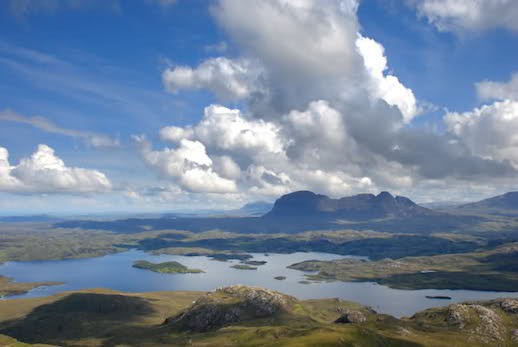 Suilven seen across Loch Sionascaig
Suilven seen across Loch Sionascaig
In actuality, Sionascaig was less accommodating. I parked near the loch and battled down through wet moor grass and tick-thick birch trees to the shore, and then swam out in bitingly cold water to the nearest island, a humpback of gneiss with a rock-garden of heathers. I explored the island briefly, found it to be uninteresting and swam back to shore. The midges came up in clouds as I tried to change into warm clothes on the sharp-pebbled beach, so I gathered my trousers and jumper and retreated in my trunks, shivering and bitten, back to the road. I was approaching my car, where a flask of hot tea was waiting on the front seat, when another vehicle came into view over the hill. Its driver stopped beside me, wound down her window and turned off her radio.
‘You’ve been swimming, haven’t you?’ she said.
Dripping wet, dressed only in my trunks, clutching my clothes, I could not deny it.
‘A bit early in the year, isn’t it?’
Goose-bumped, flinching in the wind, I could not deny that either.
‘Midges are bad today, aren’t they?’
At this point my patience for rhetorical questions expired, so I briefly explained that a friend of mine had written a book about wild swimming and as a result I couldn’t keep out of the water, and so if she would excuse me? She gave a surprised smile, reached down and picked up the audio-tape of Waterlog, to which she had been listening as she drove that lonely road on that grey day past that remote loch. It was a memorable meeting of influences – a point at which water came together with other water.
*
Roger and I first encountered one another in late 2002, and were friends until his death in the summer of 2006. In that short time a friendship grew up between us that was in part paternal-filial in its nature, but more significantly made of shared passions (landscape, literature, nature, exploration) with regard to which the thirty years between us in age seemed irrelevant. We visited each other often, corresponded by letter and email, travelled together in Ireland and the south-west of England, and Roger became unofficial godparent to my daughter Lily, for whose first visit to Walnut Tree Farm he raked into being a circular maze made of yellow mulberry leaves. Roger once wrote that he wanted his friendships to grow ‘like weeds … spontaneous and unstoppable’, and for me at least it was a weedy friendship in that sense.
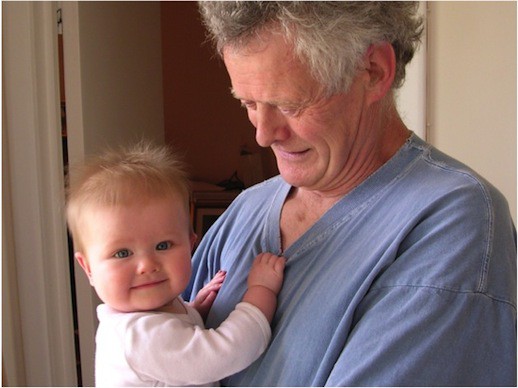 Roger with Lily, early 2004 ©Robert Macfarlane
Roger with Lily, early 2004 ©Robert Macfarlane
Roger once came to Cambridge, where I teach, to give an invited seminar to the assembled modern literature experts and graduate students of my faculty, in a high room at King’s College on whose walls Virginia Woolf had once doodled murals and graffiti. Roger’s chosen theme was water in literature ¬– and the subject ran through his fingers. He sat at the polished table, ruffled his papers, hesitated, murmured, then moved too quickly from John Keats to Wallace Stevens to Woolf to Ted Hughes. I stared dedicatedly at my shoes, embarrassed that my friend was failing to perform in front of my academic peers.
It was only later that I realized it wasn’t a failure to perform, but a refusal to conform. Cambridge seminars expect rigour and logic from their speakers: a braced subtlety of exposition and explanation, tested proofs of cause and consequence. But water doesn’t do rigour in that sense, and neither did Roger, though his writing was often magnificently precise in its poetry (precision being, to my mind, preferable to rigour ¬– the former being exhilaratingly exact and the latter grimly exacting). For Roger, water flowed fast and wildly through culture: it was protean, it was ‘slip-shape’ – to borrow Alice Oswald’s portmanteau from her river poem, Dart – and so that was how he followed it, slipshod and shipshape at once, moving from a word here to an idea there, pursuing water’s influences, too fast for his notes or audience to keep up with, joining his archipelago of watery subjects by means of an invisible network of tunnels and drains.
Waterlog also possesses this covertly connected quality, this slipshapeness. It feels spontaneous, written as if spoken – but as the dozens of closely annotated drafts of the book reveal, it was in fact densely contrived in its pattern-makings and metaphors. In one chapter, Roger set out to swim the Rhinogs, a small and wild mountain-group in north Wales
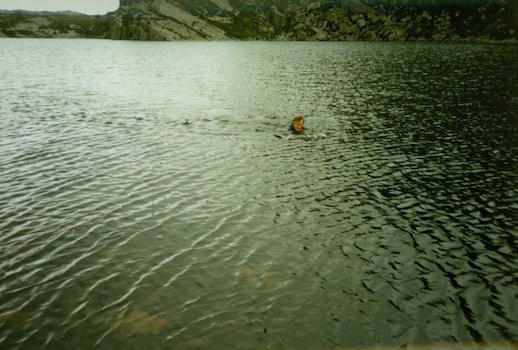 Roger ‘dooking’ in Llyn Hywel, south of Rhinog Fach ©The literary estate of Roger Deakin
Roger ‘dooking’ in Llyn Hywel, south of Rhinog Fach ©The literary estate of Roger Deakin
‘Searching the map,’ he wrote:
I had seen some promising upland streams, a waterfall, and a tarn, so I hiked off uphill through the bracken. There is so much of it in the Rhinogs that the sheep all carry it around on their coats like camouflaged soldiers. I watched a ewe standing between two rocks the shape of goats’ cheeses. They were just far enough apart to allow the animal in, and I began to understand the relationship Henry Moore perceived between sheep and stones. He saw sheep as animate stones, the makers of their own landscape. By grazing the moors and mountains they keep the contours – the light and shade – clear, sharp and well-defined, like balding picture-restorers constantly at work on every detail. The black oblongs of their pupils set deep in eyes the colour and texture of frog skin are like the enormous slate coffin-baths you see in the farmyards here; seven-foot slabs of slate hollowed into baths
Sheep like soldiers, stones like cheeses, stones like sheep, sheep like picture-restorers, sheep’s eyes like frog skin, sheep’s pupils like slate baths – this joyful promiscuity of comparison, this sprawl of simile, is characteristic of Roger’s prose. The finding of ‘likeness’ was a function of his generosity and his immense curiosity; it was also a literary expression of the idea that, as John Muir put it, ‘when we try to pick out anything by itself, we find it hitched to the whole world’. Roger loved language for its capacity to connect and relate, and as he swam through Britain he collected some of the wondrous words that ran through its waterways:
dook (noun, Scots) – a swim in open water
gull (verb, East Anglian) – to sweep away by force of running water
tarn (noun, Cumbrian/Northern English) – an upland pool or small lake
winterburna (noun, Old English) – an intermittent or ephemeral stream, dry in the summer and running in the winter
bumbel (verb, Shetlandic) – to flounder around in water
Waterlog, unlike much that gets labelled as nature writing, is very funny. There is plenty of bumbelling in it. Roger’s gently subversive sense of humour recalls that of Kenneth Grahame, Jerome K. Jerome and A. A. Milne: all of them, in their ways, water-men and river-rats. He was not afraid to don, when the temperature required it, what he called ‘the full-body condom’ of the wetsuit.
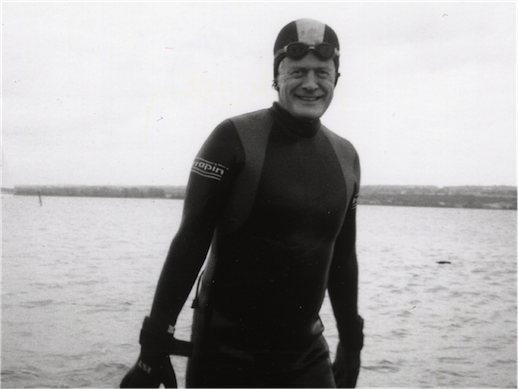 ©The literary estate of Roger Deakin
©The literary estate of Roger Deakin
Though he was also content to be seen in sleek Speedos and neoprene bedsocks.
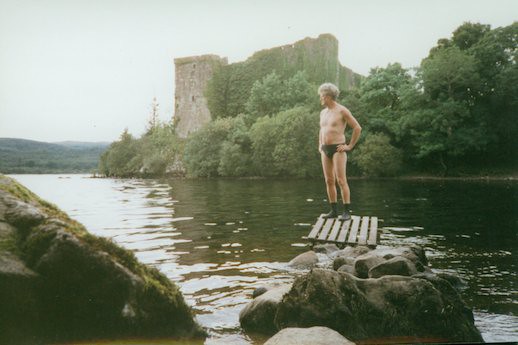 Roger swimming at Loch Awe, Southern Highlands ©The literary estate of Roger Deakin
Roger swimming at Loch Awe, Southern Highlands ©The literary estate of Roger Deakin
In one chapter of Waterlog, Roger decides to swim up the estuary of the River Erne in Cornwall. He discovers that by catching the incoming tide in the estuary mouth, he will be carried rapidly upstream:
I threw myself in and … felt the incoming tide lock onto my legs, and thrust me in towards the distant woods along the shore. Each time a frond of sea-lettuce lightly brushed me, or glued itself around my arms, I thought it was a jellyfish, and flinched. But I soon grew used to it; seaweed all around me, sliding down each new wave to drape itself about me. I kept on swimming until I practically dissolved, jostled from behind by the swell. Then, as the tide rose higher, the sandy estuary beach came into focus. The woods reached right over the water, and began accelerating past me. I found I was moving at exhilarating speed, in big striding strokes, like a fell-runner on the downhill lap. It was like dream swimming, going so effortlessly fast, and feeling locked in by the current, with no obvious means of escape. I was borne along faster and faster as the rising tide approached the funnel of the river’s mouth until it shot me into a muddy, steep-sided mooring channel by some old stone limekilns on the beach. I had to strike out with all my strength to escape the flood and reach the eddy in the shallows. I swam back up to the limekilns and crawled out onto the beach like a turtle.
Much of the magic of Waterlog is apparent here: the adventure, the unostentatious bravery, the sense of life as a game with joy as its gain, a pleasure at moving with the world and being swept along by its rhythms rather than sweeping it along with ours – and the soft bathos of that final image. He crawls out onto the beach ‘like a turtle’, which is at once comic and true, for he has been transformed by the water, much as Wart – the hero of T. H. White’s The Sword in the Stone – magicked by Merlyn, dives into a river and becomes a trout as soon as he breaks the surface. Roger felt himself at various times in the course of his swimming journeys to have become part otter, part fish, part turtle: a compound being, a merman, some of his humanity ‘dissolved’ away and replaced with the creaturely. Metempsychosis, metamorphosis: these were ideas to which Roger and I found ourselves returning in conversation – talking about Hughes and Hopkins and J.A. Baker, or the frontiers we perceived to exist within even familiar landscapes (hill-passes, watersheds, snow-lines; the move from chalk onto greenstone, or from boulder-clay onto breckland), and the transformations that might occur as you crossed them.
To enter water is, of course, to cross a border. You pass the lake’s edge, the sea’s shore, the river’s brink – and in so doing you arrive at a different realm, in which you are differently minded because differently bodied. To Roger, treelines and forest fringes also offered such frontiers. ‘To enter a wood is to pass into a different world in which we ourselves are transformed,’ he wrote; ‘it is where you travel to find yourself, often, paradoxically, by getting lost.’
——————————————————————————————————————————
The second part of The Woods and the Water runs tomorrow, from 8am GMT.
Landmarks can be bought from the Caught by the River shop, priced £15.
Robert will be reading from Landmarks at the Caught by the River Faber Social on 13 April. Information on this event can be found here.